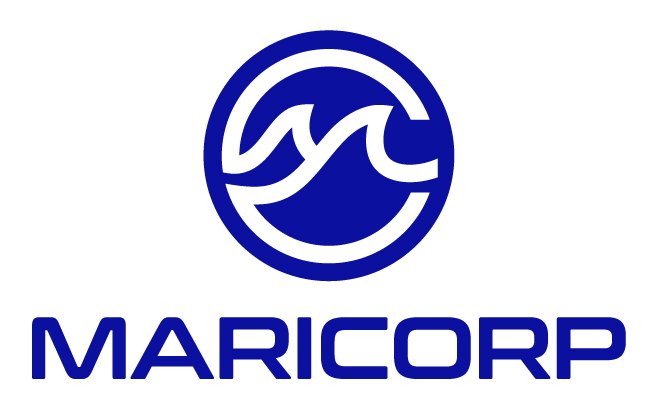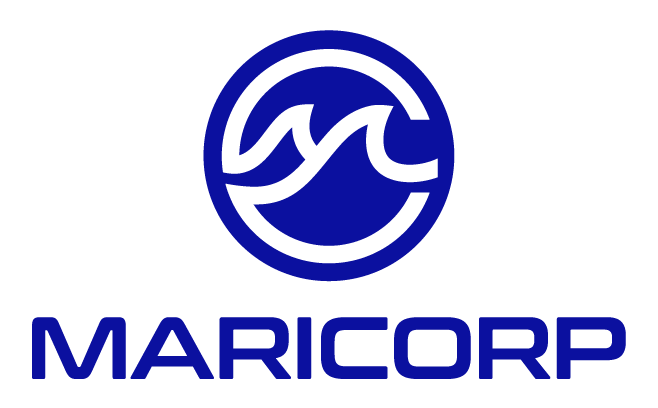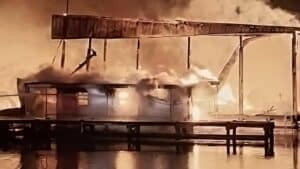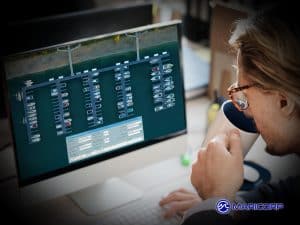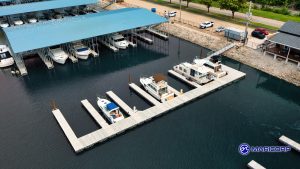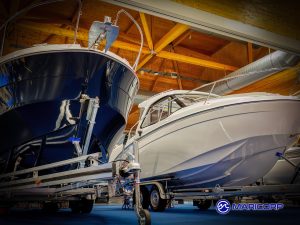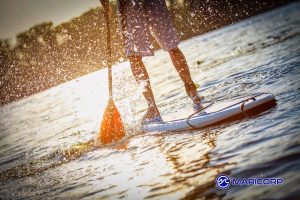Preparing for Off Season Projects – Marina Upgrades That Start Now
Why Off Season Projects Begin Before Summer Ends
For many marinas, the quiet of winter is anything but idle. It’s a critical time for infrastructure repairs, dredging, facility upgrades, and strategic planning but those off season projects don’t happen on the fly. The most effective marina improvements begin while summer is still in full swing, with proactive scheduling, contractor coordination, and supply chain awareness.
By identifying project priorities in August or early September, you give your team time to secure permits, equipment, and vendor bids ensuring off season work kicks off smoothly as soon as the docks begin to clear. From dock replacements and fuel system upgrades to landscaping overhauls and restroom renovations, a solid runway ensures your work gets done before next spring’s first slip reservation.
This planning stage is also your opportunity to revisit deferred maintenance or community suggestions from earlier in the season. What were the recurring complaints this summer? What assets have reached end of life? Which upgrades for your off season projects could help retain slip holders or attract transient boaters next year?
1. Reviewing Capital Needs and Budget Flexibility
The first step in organizing off season projects is a thorough review of capital allocations. While your annual maintenance budget may already earmark funds for standard repairs, larger marina improvements, such as piling replacements, shoreline stabilization, or bathhouse renovations, require long range financial forecasting and, often, board or ownership approval.
Revisit your capital improvement plan and ask:
- What projects were postponed last year that now demand priority?
- Are there grants, state programs, or federal infrastructure funds available to offset costs?
- Have fuel dock revenues, transient traffic, or slip rentals exceeded budget forecasts enough to allow for reinvestment?
For example, the Boating Infrastructure Grant Program (BIG) offers competitive funds for transient dockage and boater amenities. Planning ahead now for your off season projects gives you time to prepare applications before deadlines roll around in the fall or winter.
Working with your accountant or marina financial planner in August also helps you identify potential tax advantages for repairs completed within the calendar year.
2. Infrastructure Assessments Start Before Haul‑Out
With boats still in the water and systems running full tilt, now is the time to take stock of wear and tear. Conducting infrastructure assessments in August or early September provides a clearer picture of what off season projects will be most urgent and it gives contractors time to bid accurately while your marina’s needs are fresh.
Walk the property and note:
- Cracked decking, loose hardware, or corrosion on floating docks
- Issues with electrical pedestals, water lines, or fire suppression systems
- Sedimentation buildup at the entrance or around fuel docks (for dredging estimates)
- Shoreline erosion, deteriorating bulkheads, or crumbling riprap
- Fuel tank inspection dates and vent system compliance
If you’ve had severe weather this summer, those assessments are even more important. Use a formal checklist or maintenance tracking tools to document findings. Platforms like Marina Master include mobile inspection and asset management capabilities to schedule recurring maintenance and capture photos directly into the system. Others like Dockwa, a smart marina systems provider, allow you to monitor electrical consumption, slip occupancy, and even mooring activity using real time wireless sensors. Dockwa’s interface for managers, staff, and customers helps streamline communication and decision making, while integrations with top Marina Management Software platforms offer flexibility in planning and execution.
Prioritizing repairs before haul out avoids surprises during colder months when crews and resources are harder to source.
3. Permitting and Long Lead Marina Improvements
Some of the most ambitious off season projects, from dock expansions to dredging, require advanced planning, especially when regulatory permits or contractor scheduling is involved. August and early September are prime months to kick off these longer lead improvements while permitting offices are still operating at full capacity and weather related delays are minimal.
Typical marina improvements that require permitting:
- Dredging (state and federal environmental clearance often required)
- Bulkhead repair or replacement
- New dock installation or major reconfiguration
- Fuel system upgrades
- Electrical or lighting system improvements over water
Before initiating any of these large scale improvements, it’s smart to consult directly with your marina contractor or dock system provider. They can help you create a phased project plan, offer guidance on realistic timelines, and flag which improvements may require engineering, surveys, or compliance reports. This collaboration ensures your game plan aligns with both permitting windows and available labor during the quieter months.
To better understand the regulatory framework and planning tools available for coastal infrastructure, the NOAA Digital Coast platform offers resources curated specifically for the coastal management community. While tailored for coastal regions, the same tools and principles can help guide marina projects on inland lakes and rivers.
Even more routine upgrades like running new power conduits, adding EV charging, or improving ADA compliance, can have hidden permitting needs. Bringing in an engineer or marina consultant during the planning phase saves time and helps you uncover secondary projects you may not have budgeted for.
By tackling permitting now, you’ll avoid project bottlenecks during winter and be first in line when contractors begin booking for spring.
4. Budgeting with Realistic ROI in Mind
One of the biggest challenges in planning off season projects is balancing ambition with available budget. While it’s tempting to delay investments until a “larger overhaul,” smaller phased upgrades can often provide a stronger return on investment (ROI) and minimize operational disruptions.
Smart ways to approach budgeting:
- Segment projects into tiers (e.g., essential repairs, preventative upgrades, and “wish list” enhancements)
- Use occupancy and usage data from summer operations to justify infrastructure updates
- Compare ROI timelines of guest amenities (Wi-Fi, shade structures, rental docks) vs. backend upgrades (utilities, security, signage)
- Don’t overlook grants or tax incentives, especially for clean marina initiatives or energy efficient systems
Data backed decisions go further than gut instinct. If your summer power usage spiked due to new EV charging needs or onboard air conditioning loads, that may justify panel upgrades or smarter metering tools. Marina specific technology providers like Dockwa can help you translate slip occupancy, utility consumption, and mooring demand into actionable budget forecasts.
The goal isn’t just to “spend the budget” before year end, it’s to deploy capital in ways that reduce future maintenance, attract higher value slip holders, or expand your transient revenue base. If your fall slip reservations were unusually late or you had a high percentage of short term stays, that may point to an opportunity for automation or incentive based programs.
Some marina owners use a percentage based strategy: allocating 70% of their fall project budget to necessary improvements and 30% to upgrades tied to revenue generation. Others revisit their capital improvement plan (CIP) annually to adjust priorities based on market conditions and boater feedback.
By budgeting with ROI in mind, you’re not just improving infrastructure, you’re strengthening long-term profitability.
5. Don’t Wait on Permit Paperwork
Permit delays are one of the most common and costly reasons marina improvement projects stall out. From dredging and dock additions to fuel system upgrades and erosion control measures, almost every structural improvement within or near the water requires one or more permits, and that means navigating a bureaucratic maze.
The problem? It’s rarely a single permit. Multiple agencies at the federal, state, and local levels, each with their own jurisdiction, often require separate applications, environmental assessments, and public notices. The result is a juggling act of timelines, reviews, and revisions that, if not timed just right, can cause frustrating holdups for your off season projects.
Examples of permitting complications:
- Wetland or habitat impact reviews
- Coastal zone management approvals
- Army Corps of Engineers Section 10 and 404 permits
- State DNR reviews on waterway access or aquatic habitat
- Local zoning compliance and land use permits
Even one missing document or misaligned review period can push your timeline back weeks or months. And if your region has seasonal construction moratoriums, especially for in water work, you could miss your window entirely.
That’s why starting early matters. Use the off season to:
- Outline your project scope with contractors or engineers
- Identify all agencies with permitting authority
- Submit applications in sequence to avoid overlap delays
- Track public comment periods or additional review cycles
The permitting process isn’t just paperwork, it’s project control. Waiting until spring may mean scrambling for contractor availability just as you’re realizing you don’t have the green light to proceed. Start the ball rolling in the fall, when time is on your side.
6. Coordinate Capital Projects with Your Team
Off season projects don’t just involve contractors and construction crews, they require full alignment from your marina’s internal team. From dockhands to general managers, everyone plays a role in preparing the site, communicating updates to boaters, and adjusting day to day operations during any construction or maintenance window.
This is especially important for capital improvements like dock reconfiguration, utility trenching, landscaping overhauls, or paving projects that may impact customer access or key infrastructure.
Start with a cross department planning session. Loop in operations, customer service, groundskeeping, and accounting staff to create a unified view of what’s planned, who’s affected, and when each step should occur. A few must have items for the agenda:
- Confirm anticipated project scope and start dates
- Identify temporary closures or detours for work zones
- Discuss contractor needs (electrical shut offs, water line marking, restricted access)
- Coordinate communication strategies for boaters and vendors
As timelines and tasks evolve, maintaining a shared calendar or Gantt chart (such as via Trello, ClickUp, or a simple Google Sheet) can help managers visualize overlap points and minimize operational disruptions. Daily check ins may not be necessary, but consistent weekly updates keep everyone looped in.
You’ll also want to assign a clear point of contact for each stage of the improvement. Is your general manager the go to for permit follow ups? Is the facilities lead overseeing vendor coordination? Avoiding confusion now can prevent minor oversights from becoming costly setbacks later.
Pro tip: Use this opportunity to survey staff for input on maintenance pinch points. Line level employees often spot recurring issues like outdated lighting, unsafe trip hazards, or chronic drainage problems, that can be rolled into larger marina improvements.
These conversations also reinforce that off season projects aren’t just about docks and dredging, they’re about building a better workplace, reducing headaches, and ultimately improving the guest experience for everyone.
7. Use the Downtime to Test New Tech
When peak season winds down, so do the daily demands that keep your team constantly on their toes. This quieter window creates an ideal environment to pilot new systems and upgrades that may have been too disruptive to deploy mid season.
For many marinas, off season projects increasingly include tech based marina improvements, everything from implementing automated billing software to piloting new access control systems or IoT monitoring for fuel and water use.
One area of growing interest is smart marina technology, which streamlines communication, boosts revenue visibility, and improves customer satisfaction. Solutions like Falco integrate sensors and dashboards for slip occupancy, mooring status, power usage, and even customer activity trends. Testing these systems during the slower months allows your team to get comfortable with new tools before the spring rush begins.
If you’re considering upgrading your point of sale system, CRM platform, or online booking interface, this is also the time to test integrations, conduct internal training, and solicit feedback from staff. Try running parallel systems for a short time or offering sneak peeks to loyal customers who can offer valuable early insights.
Other worthwhile pilots include:
- Dockside Wi-Fi upgrades with usage analytics
- Staff scheduling platforms to streamline time off requests and labor forecasting
- Mobile app interfaces for slip renters and transient guests
- Touchless gate or pump out activation systems
- Integrated lighting and camera security systems
Just like your infrastructure, your tech stack needs scheduled reviews and occasional overhauls to stay competitive. By making digital upgrades a part of your off season projects, you not only modernize your operation but give staff time to adopt and adapt without the pressure of summer’s full house.
8. Evaluate Customer Experience Infrastructure
Of season projects offer more than operational and structural improvements, they’re also a strategic opportunity to enhance the guest experience in meaningful, visible ways. Before next spring’s slip contracts are signed, take stock of the small details that shape how your marina is perceived.
Start by walking the site from a first time visitor’s perspective. Are wayfinding signs faded or confusing? Are restrooms spotless, or just “clean enough”? Are picnic areas inviting or sun‑bleached and cracked? These non‑glamorous details influence repeat visits and can elevate your marina’s reputation without requiring major capital investment.
This is also the perfect season to inspect and upgrade:
- Dock carts, grills, and community use gear
- Parking lots and ADA accessibility
- Office waiting areas or check in kiosks
- Guest Wi‑Fi signal strength across docks
- Landscaping buffers between public and private use areas
- Pet friendly zones or waste stations
According to a Statista survey, 64% of consumers report that the cleanliness of a store influences their likelihood to return, a strong reminder that physical appearances significantly impact guest satisfaction across service environments.
Now’s also a great time to gather customer feedback via short surveys or focus groups with end of season slip holders. You may uncover suggestions like better lighting at the fish-cleaning station or clearer lane markings at the boat launch. Staff input can also be invaluable; dockhands or maintenance teams often notice recurring minor issues, such as slippery walkways or signage gaps, that can be addressed easily during the off season.
These low-cost, high impact improvements reflect thoughtful service and go a long way in reinforcing your commitment to guest satisfaction.
9. Audit Your Contracts and Vendors
As the season winds down, it’s wise to take stock of the partnerships and service agreements that keep your marina running. The off season provides a natural checkpoint to review vendor performance, renegotiate contracts, and identify better options before renewal deadlines sneak up.
Start by assembling a list of all current vendors, including:
- Fuel and lubricant suppliers
- Waste and pump out services
- Landscaping and pest control providers
- Wi-Fi and communications contracts
- Dock maintenance or diver services
- Insurance policies and compliance consultants
For each, ask:
- Did this vendor meet response time expectations?
- Was the quality of service consistent throughout peak season?
- Are there competitors offering better value or support?
- Have rates increased without a clear explanation?
This is also the time to review vendor compliance and liability documentation. Ensure that all third party contractors carry valid certificates of insurance, follow marina safety protocols, and have up to date contracts on file. These precautions reduce your liability and set expectations heading into the next season.
If you rely on seasonal labor or subcontractors for repairs, maintenance, or landscaping, evaluate the cost, availability, and quality of those arrangements as well. If staffing or supply issues arose, use this review period to explore alternate vendors or develop backup agreements that can be activated quickly.
In some cases, you may find opportunities to bundle services (e.g., pest control and landscaping, or pump out and fuel delivery), which can simplify billing and streamline communications. Make use of this administrative breathing room to compare quotes, solicit bids, or strengthen long standing partnerships with more favorable terms.
Your marina’s vendor ecosystem should be as well tuned as its infrastructure. A thorough contract audit ensures you’re not carrying dead weight or missing out on smarter, more cost effective option.
Autumn Action, Spring Success
Tackling off season projects isn’t just about fixing what’s broken, it’s about setting your marina up for long term success. From upgrading digital systems and securing permits to optimizing vendor contracts and exploring capital improvements, thoughtful preparation this fall means smoother operations come spring. By using this natural lull to audit, plan, and improve, marina operators position themselves to offer better service, boost revenue, and reduce stress once the docks get busy again.
Additional Reading:
- United States Army Corps of Engineers Permitting
- Understanding the Marina Permitting Acquisition Process
- Rivers and Harbors Act – Section 10
- Clean Water Act – Section 404
- Signage Statistics: Do Signs Actually Boost Small Business Growth?
- How Retail Store Cleaning Services Impact Your Brand Image
Related Articles:
- Six Things to Consider When Planning a New Dock
- Return on Investment (ROI) When Planning a New Dock
- Planning and Timing – When Planning a New Dock
- Permitting Requirements – When Planning a New Dock
About MariCorp
Maricorp is one of the largest floating boat dock manufacturing and construction companies in the United States, specializing in galvanized steel floating docks and boat lift systems. With projects spanning coast-to-coast, Maricorp provides marina consultation and design, marine construction, marina repair and renovation, and boat dock disaster response and demolition.
